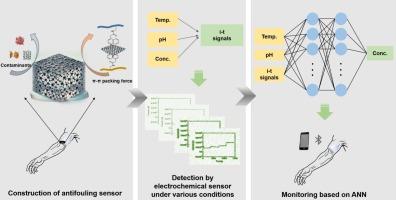机器学习辅助可穿戴防污传感器在动态条件下进行可靠的汗液分析
IF 4.9
2区 化学
Q1 CHEMISTRY, ANALYTICAL
引用次数: 0
摘要
在实际使用过程中,可穿戴式汗液传感器面临着生物污垢和动态生理变化带来的持续可靠性挑战。为了克服这些双重限制,我们引入了一种范式转换的协同设计策略,将防污催化水凝胶与机器学习驱动的动态补偿集成在一起。我们的平台特点:(1)一种肽复合水凝胶,包含Au-PdNPs/rGO纳米复合物和工程亲水肽,具有卓越的防污性能(未稀释汗液中8.3%的信号损失),同时对尿酸(UA)具有特定的催化活性;(2)基于1217个同时跨越不同生理条件的实验数据集训练的人工神经网络。这种协同方法实现了三个关键的进步:首先,水凝胶的极端亲水性(9.01°接触角)可以防止汗水污染表面,保持电极活性。其次,人工神经网络对环境干扰与目标信号进行动态解耦,克服了传统传感器“单变量优化”的局限性。第三,真实汗液验证显示准确的UA预测,显著优于静态校准方法和匹配ELISA的准确性。通过将防污材料工程与自适应机器学习相结合,本研究建立了可靠的可穿戴生物传感新框架,在真实动态条件下实现了预测精度(R2 = 0.9989)。本文章由计算机程序翻译,如有差异,请以英文原文为准。

Machine learning assisted wearable antifouling sensor for reliable sweat analysis under dynamic conditions
Wearable sweat sensors face persistent reliability challenges from biofouling and dynamic physiological variations during real-world use. To overcome these dual limitations, we introduce a paradigm-shifting co-design strategy integrating an antifouling catalytic hydrogel with machine learning-driven dynamic compensation. Our platform features: (1) A peptide composite hydrogel incorporating Au-PdNPs/rGO nanohybrids and engineered hydrophilic peptides, achieving exceptional antifouling performance (8.3 % signal loss in undiluted sweat) while providing specific catalytic activity toward uric acid (UA); (2) An artificial neural network (ANN) trained on 1217 experimental datasets spanning simultaneously varying physiological conditions. This synergistic approach enables three critical advances: First, the hydrogel's extreme hydrophilicity (9.01° contact angle) prevents surface fouling by sweat, maintaining electrode activity. Second, the ANN dynamically decouples environmental interference from target signals, overcoming the “single-variable optimization” limitation of conventional sensors. Third, the real sweat validation demonstrates accurate UA prediction, significantly outperforming static calibration methods and matching ELISA accuracy. By unifying antifouling material engineering with adaptive machine learning, this work establishes a new framework for reliable wearable biosensing, achieving prediction accuracy (R2 = 0.9989) under real-world dynamic conditions.
求助全文
通过发布文献求助,成功后即可免费获取论文全文。
去求助
来源期刊

Microchemical Journal
化学-分析化学
CiteScore
8.70
自引率
8.30%
发文量
1131
审稿时长
1.9 months
期刊介绍:
The Microchemical Journal is a peer reviewed journal devoted to all aspects and phases of analytical chemistry and chemical analysis. The Microchemical Journal publishes articles which are at the forefront of modern analytical chemistry and cover innovations in the techniques to the finest possible limits. This includes fundamental aspects, instrumentation, new developments, innovative and novel methods and applications including environmental and clinical field.
Traditional classical analytical methods such as spectrophotometry and titrimetry as well as established instrumentation methods such as flame and graphite furnace atomic absorption spectrometry, gas chromatography, and modified glassy or carbon electrode electrochemical methods will be considered, provided they show significant improvements and novelty compared to the established methods.
 求助内容:
求助内容: 应助结果提醒方式:
应助结果提醒方式:


